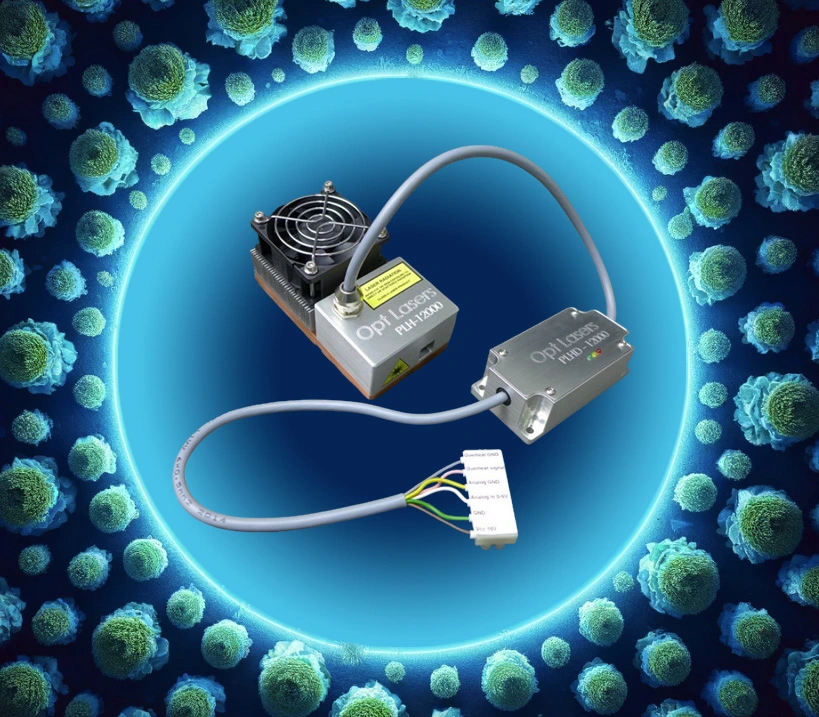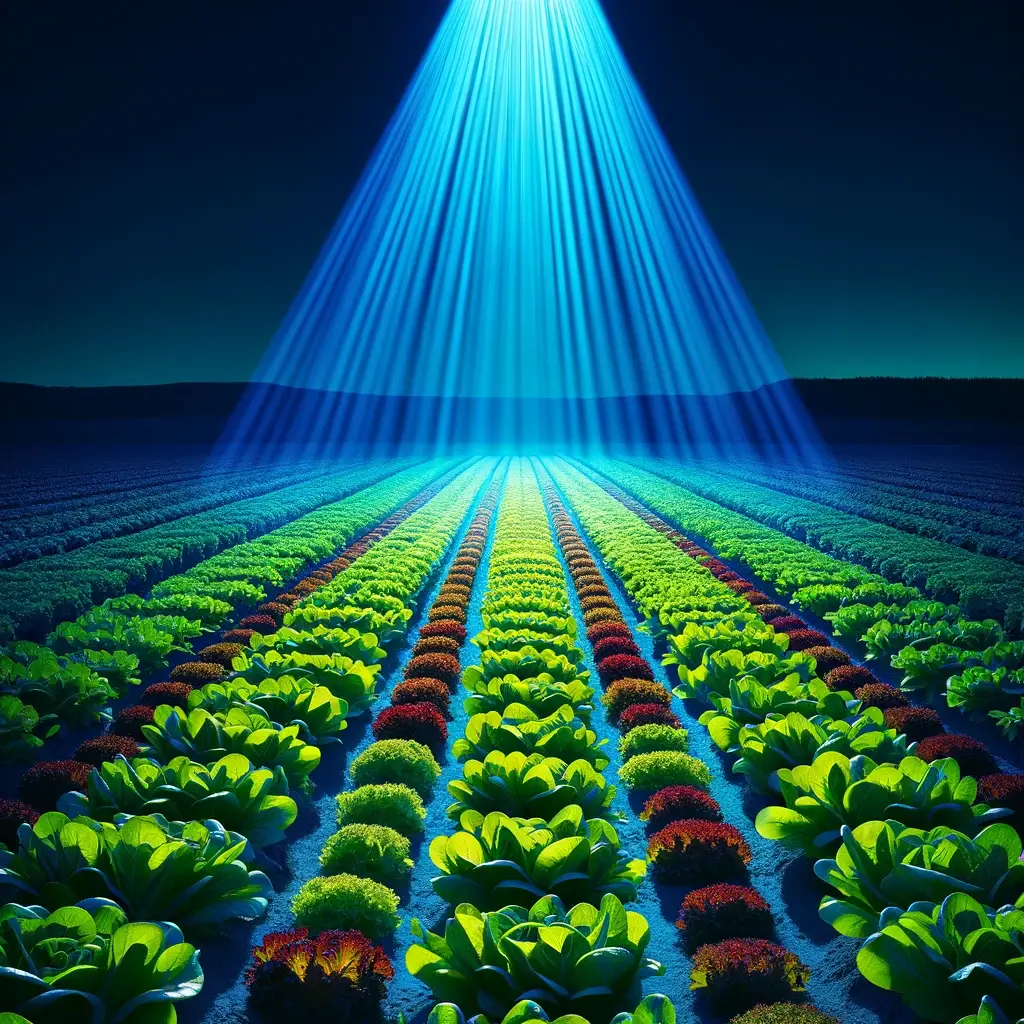From Precision Engraving to Green Agriculture: The Historical Journey of the Opt Lasers PLH-12000
The First High-Power Blue Laser in the Field: PLH-12000
The Opt Lasers PLH-12000 laser engraving head once stood as an achievement in laser technology, delivering unparalleled power and precision for a broad spectrum of applications. Its construction, a testament to a rigorous commitment to excellence, and its incorporation of leading-edge features made it a professional-grade powerhouse. Initially designed for the precision work of engraving, it found a surprising and wholly unintended second life in agriculture, specifically in weed control.
This innovative tool's journey from a premier engraving device to a pivotal agricultural implement marked a significant shift in how technology could be repurposed to address pressing environmental and economic challenges. As it phased out of production, the legacy of the PLH-12000 highlighted a transformative period where precision laser technology was harnessed to reduce reliance on chemical herbicides and minimize manual labor, paving the way for more sustainable farming methods.
In its time, the PLH-12000 demonstrated the potential of laser technology to transcend its original applications, offering solutions to age-old agricultural problems. This historical pivot in its utilization reflects a broader narrative of technological adaptation and sustainability in agriculture, showcasing how innovations can lead to unexpected environmental benefits.

Technical Overview: The PLH-12000 Laser Engraving Head's Capabilities and Features
The Opt Lasers PLH-12000 was more than just an ordinary laser engraving head. It brought together a high power output of 12W and operated at a peak wavelength of 445 nm, offering significant versatility across multiple materials and applications. Its advanced features included a comprehensive thermal protection mechanism, ensuring the laser head's temperature was constantly monitored and regulated, preventing potential overheating scenarios. This was further supported by the inclusion of the PLHD-12000 driver, designed to seamlessly manage operation and safeguard the laser diode.
The PLH-12000's aluminum body was crafted for optimal heat dissipation, aiding in cooling the laser head efficiently and allowing for mounting on flat surfaces easily. Its design facilitated straightforward installation and setup, making it a top choice for engraving, cutting, and precision machining tasks. Moreover, the laser head and its accompanying PLHD-12000 controller featured a fail-safe overheat protection; activating a LED warning system at specific temperature thresholds and automatically shutting off the laser diode to prevent damage until the temperature normalized.
The PLH-12000’s capability to be controlled via TTL, PWM, and analog signals ensured that it could seamlessly integrate into existing systems with minimal hassle. This adaptability, combined with its robust power output and safety features, made the PLH-12000 a standout product in the realm of laser technology.
Revolutionizing Agriculture: The PLH-12000's Role in Precision Laser Weeding
As the global population continues to rise, the demand for increased food production becomes more pressing. Among the myriad challenges faced by the agricultural sector, ineffective weed control stands out as a significant impediment to maximizing horticultural yield. Traditional weed management methods have often been scrutinized for their environmental impact and potential risks to food safety. In response, the agricultural industry is turning towards more sustainable and safe alternatives. Leveraging advancements in AI, machine vision, and robotics, laser weeding emerges as a precise, organic, highly automated, and cost-efficient approach to weed management.
At the heart of this technological revolution is blue laser technology. Research has demonstrated that blue light is particularly effective in targeting organic matter, making it exceptionally suitable for weed control applications. Unlike CO2 lasers that operate by heating the weeds to damage their cellular structure, blue diode lasers offer a more efficient approach, based on the high absorption of blue light by chlorophyll. Furthermore, these systems are characterized by their compact size, light weight, and energy efficiency, rendering them ideal for agricultural use.
Within this context, the PLH-12000 stands out, not just as a tool for precision engraving but as a cornerstone in the evolution of agricultural technology. Its utilization in laser weeding signifies a forward leap in developing non-chemical, environmentally friendly weed management strategies that align with the future of sustainable farming.
Empirical Evidence: The Scientific Validation of Laser Weed Control with PLH-12000
The innovative application of the PLH-12000 laser engraving head for laser weeding has been demonstrated through experimental studies conducted by the Latvia University of Life Sciences and Technologies [1]. These studies aimed to assess the efficiency and effectiveness of using a 445 nm semiconductor laser, specifically the PLH-12000, in robotized weed control applications. Mounted on an industrial robot manipulator, the PLH-12000 was evaluated for its potential to manage weeds by varying its movement speed, treatment pattern trajectory, and maintaining its output power at a constant maximum.
The experimental setup allowed for precise control over the laser, enabling targeted treatment of weed areas with predefined patterns. This approach favored a practical application scenario where precision treatment of each leaf is less feasible, mirroring real-life conditions in agricultural settings. The laser's application covered full canopy areas of weeds, utilizing a spiral pattern that aimed to reduce weed biomass significantly.
Preliminary results from these studies indicated that the PLH-12000 could effectively limit weed growth, offering a promising alternative to traditional weed management methods. Notably, the effectiveness of the laser treatment was not significantly influenced by the type of pattern used but was more correlated to the size of the treatment area relative to the plant canopy. Additionally, the studies suggested that the energy amount per square unit of area and the treatment pattern size could be optimized for enhanced energy efficiency and effectiveness in weed control.
Moreover, comparisons with other research highlighted the potential of the PLH-12000 in achieving biomass reduction at energy levels comparable to or better than those achieved with other laser technologies. This indicates a significant step forward in the development of sustainable, non-chemical methods of weed control that could benefit agricultural practices by reducing dependency on herbicides and minimizing the impact on the environment.
These findings underscore the versatility and potential of laser technology, such as the PLH-12000, in agricultural applications beyond its original design purposes. The ability to repurpose laser engraving technology for effective weed management presents a novel and environmentally friendly approach to addressing one of agriculture's persistent challenges.

Looking Forward: The Future of Laser Weed Management
The evolution of the PLH-12000, from an advanced tool designed for cutting and engraving to a pioneering solution in laser weed management, highlights a serendipitous journey of technological adaptation. Initially, none could have anticipated that a laser engineered for precision in industrial applications would find its calling within the fields of agriculture, transforming weed control practices. This unforeseen application not only underscores the versatility of laser technology but also its potential to contribute to sustainable farming solutions.
The PLH-12000 will forever be etched in history as the first high-power blue laser to be repurposed for this innovative application. Its legacy serves as a testament to the ingenuity and adaptability of technology, paving the way for a future where precision and environmental stewardship go hand in hand in the pursuit of agricultural advancement. As we continue to explore and refine these technologies, the promise of a more sustainable, efficient, and productive farming future becomes increasingly tangible, with the PLH-12000 marking the beginning of this transformative journey.
Today, as we venture beyond the capabilities of the PLH-12000, our arsenal includes much more powerful lasers specifically tailored for agricultural needs, pushing the boundaries of laser weeding further. Our research and development efforts have yielded more powerful and versatile laser systems, showcasing continuous advancements in agricultural technology. These newer systems offer enhanced precision, efficiency, and adaptability, further revolutionizing weed control practices in agriculture. Our most advanced laser weeding system currently is the GLE-FS-50-B, which consists of a 50W laser source FS-50-B. This system is ideal for thorough testing of laser weeding capabilities due to the ability to adjust the focused beam size, from 120 um even up to 2 mm diameter.
References:
[1] Experimental efficiency evaluation of 445 nm semiconductor laser for robotized weed control applications, DOI: 10.15159/ar.20.135
Blue diode laser advantages:
- Wavelength highly absorbed by plants - no need for exceedingly high optical powers
- Non-contact method means no physical damage
- Environmentally friendly
- Compact size and low weight
- Cost-effective, requires minimal maintenance
